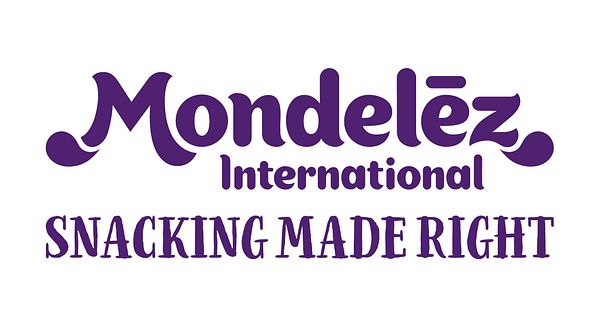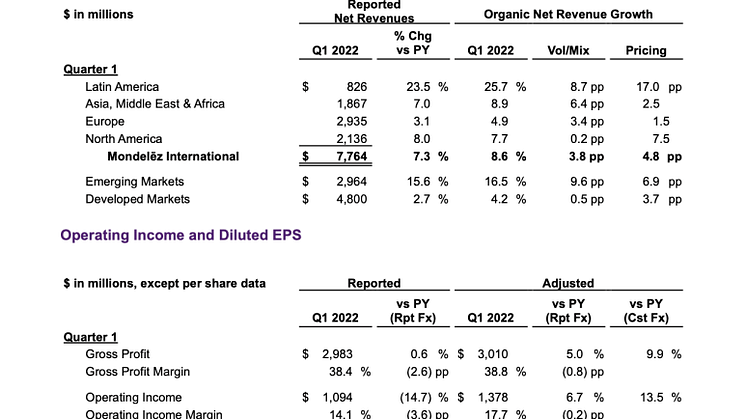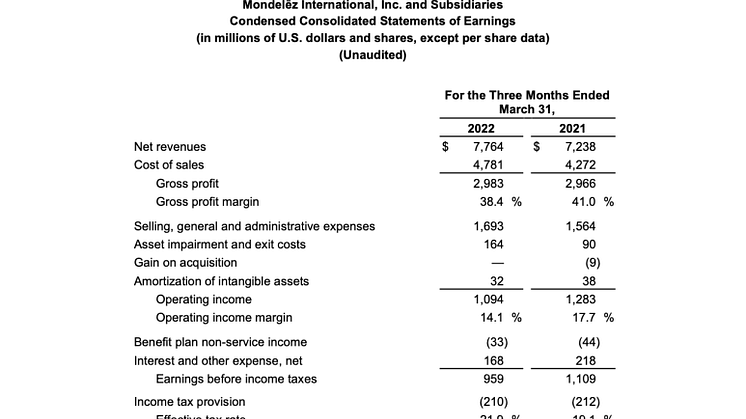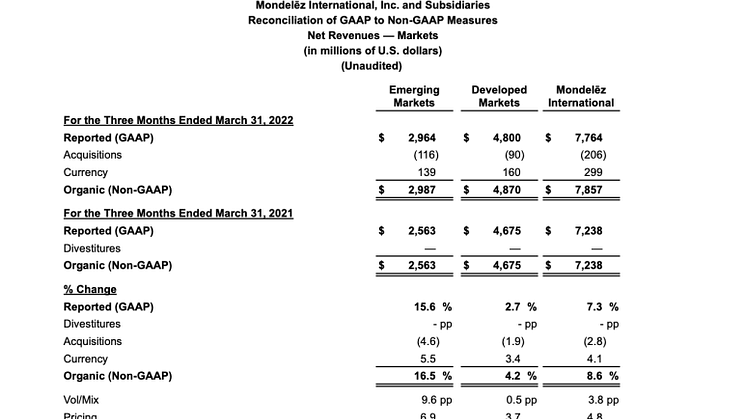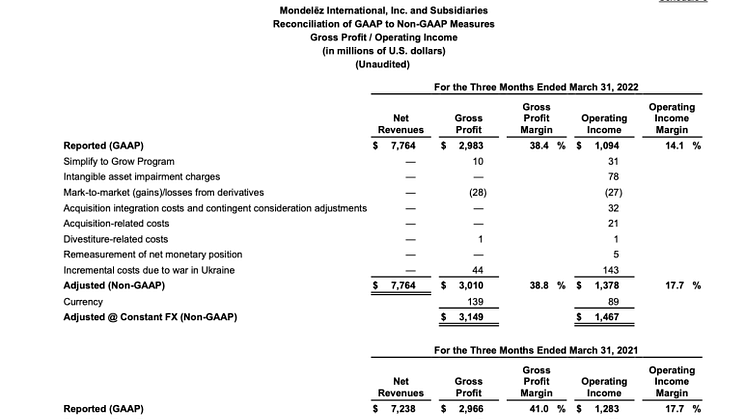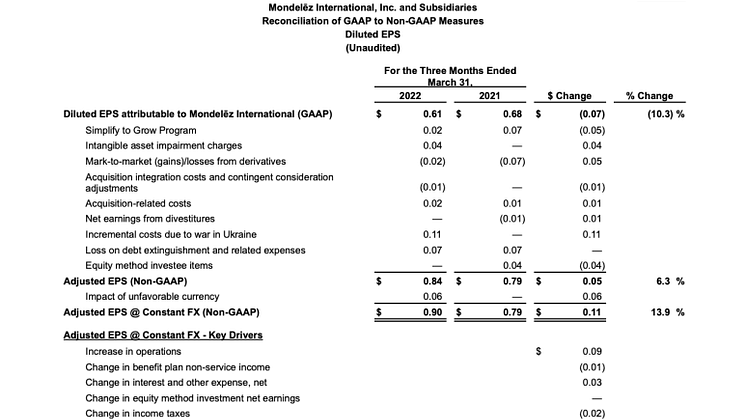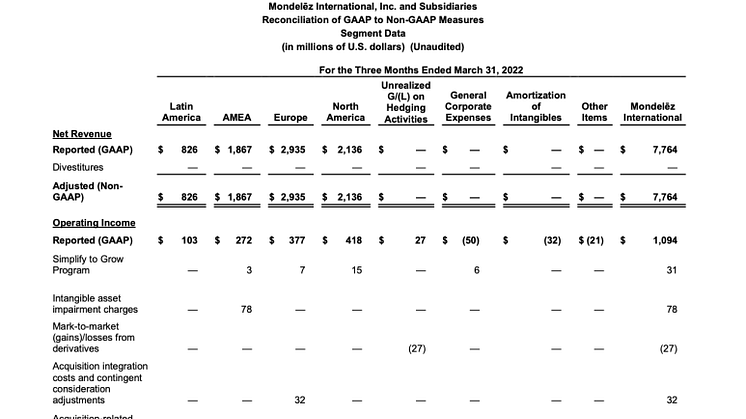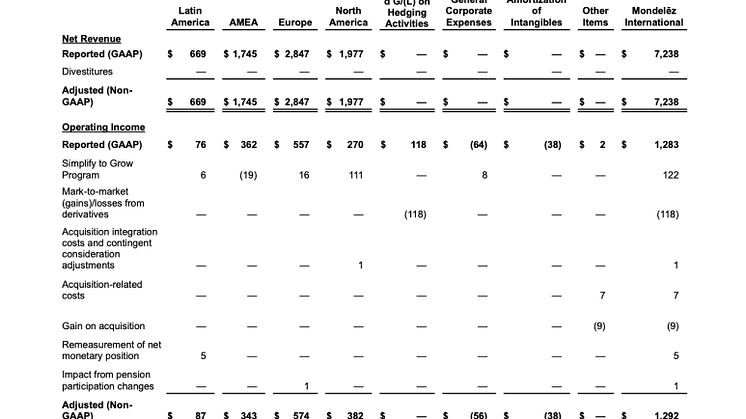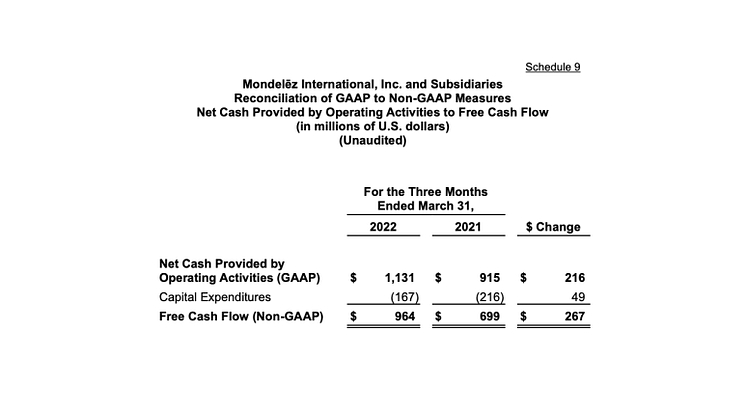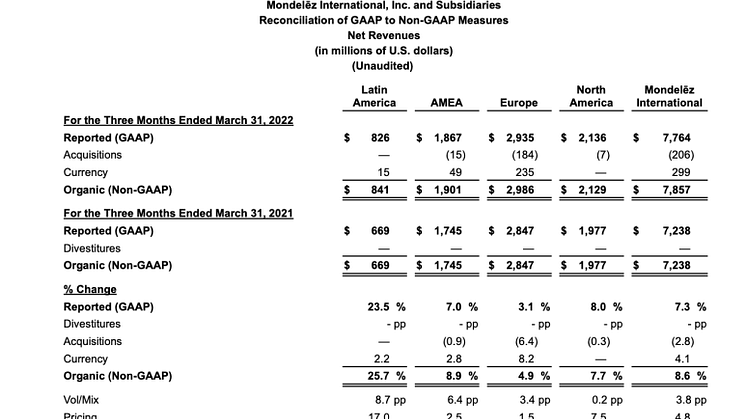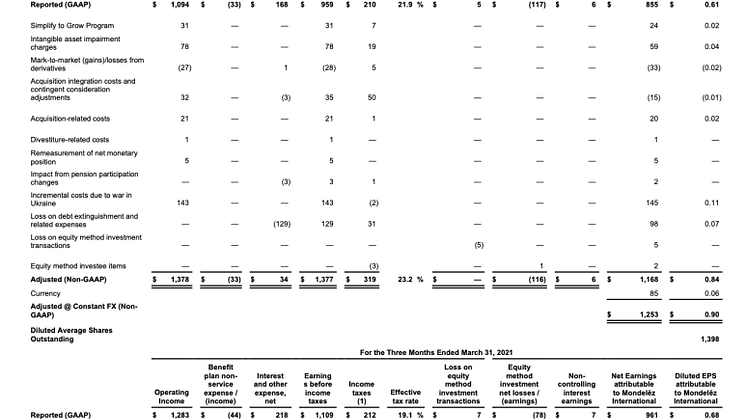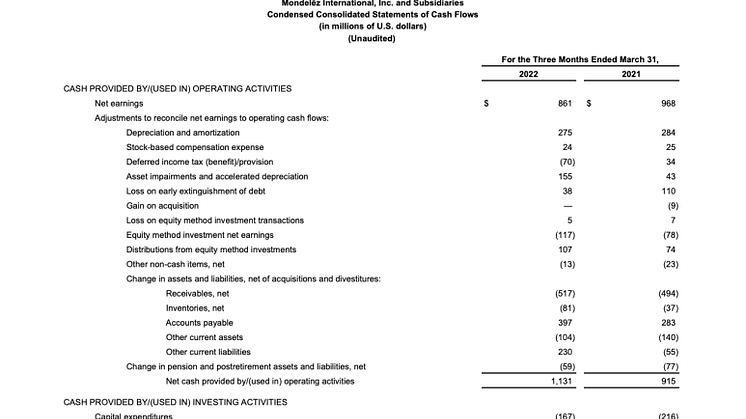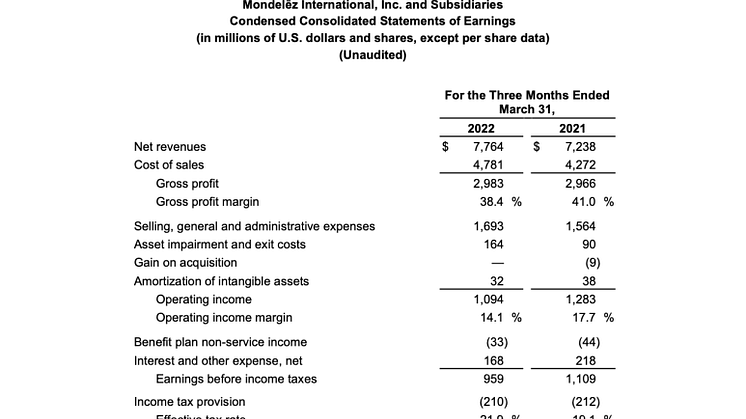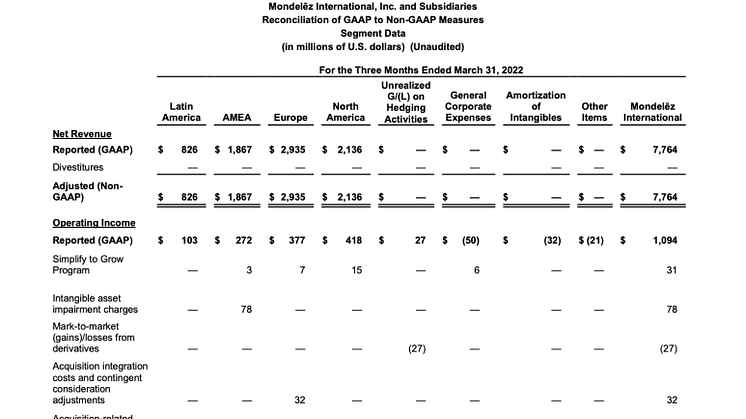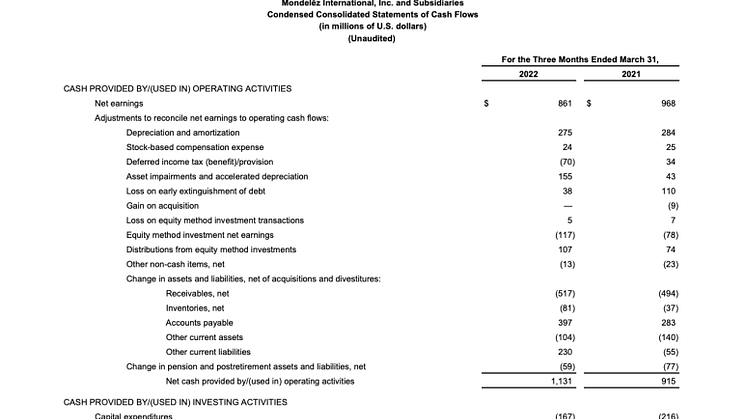
Press release -
Mondelēz International Reports Q1 2022 Results
First Quarter Highlights
- Net revenues increased +7.3% driven by Organic Net Revenue(1) growth of +8.6%
- Diluted EPS was $0.61, down -10.3%; Adjusted EPS(1) was $0.84, up +13.9% on a constant-currency basis
- Cash provided by operating activities was $1.1 billion, an increase of +$0.2 billion versus prior year; Free Cash Flow1 was $1.0 billion, +$0.3 billion
- Return of capital to shareholders was $1.2 billion
- Announced agreement to acquire Ricolino, Mexico's leading confectionery company with iconic brands and strong distribution capabilities, doubling the size of our Mexico business
- Appointed Mariano Lozano to the role of EVP and President, Latin America
Mondelēz International, Inc. (Nasdaq: MDLZ) reported its first quarter 2022 results.
"We delivered strong top-line results in our first quarter, driven by higher pricing and strong volume growth. Our chocolate and biscuit businesses continue to power our virtuous cycle of attractive revenue growth, strong profitability and robust cash flow," said Dirk Van de Put, Chairman and Chief Executive Officer. "Demand remains strong across both developed and emerging markets, with all our
regions posting growth. We expect elevated levels of input cost inflation to continue through the remainder of the year, and we will continue to take necessary actions to offset this dynamic - including a broader revenue growth management agenda, ongoing cost discipline, and further simplification within our business. We remain confident in our strategy and ability to create long-term value, while recognizing the need to stay agile to navigate the dynamic economic and geopolitical environment. We are also excited about our recently announced agreement to acquire Ricolino that will step-change our presence in the priority market of Mexico -- adding to our portfolio some of the country's most beloved chocolate and candy brands, while broadening our distribution footprint with more than 2,100 direct store delivery routes reaching 440,000 traditional trade outlets."

MDLZ Q1 2022 Earnings Release Content
First Quarter Commentary
2022 Outlook
growth, higher cost of goods sold inflation, the timing effect of additional pricing actions and the impact of the war in Ukraine.
For 2022, the company now expects 4+ percent Organic Net Revenue growth, which reflects the strength of its first quarter and higher pricing related to increased input costs. The company also now expects mid-to-high single digit Adjusted EPS growth on a constant currency basis due to the current estimates of the loss of earnings from the war in Ukraine and material commodity cost increases due primarily to increases in energy costs. The company's Free Cash Flow outlook remains at $3+ billion. The company estimates currency translation would decrease 2022 net revenue growth by approximately 3 percent(3) with a negative $0.17 impact to Adjusted EPS(3).
Outlook is provided in the context of greater than usual volatility as a result of COVID-19 and geopolitical uncertainty.
Conference Call
Mondelēz International will host a conference call for investors with accompanying slides to review its results at 5 p.m. ET today. A listen-only webcast will be provided at www.mondelezinternational.com. An archive of the webcast will be available on the company’s web site.
About Mondelēz International
Mondelēz International, Inc. (Nasdaq: MDLZ) empowers people to snack right in over 150 countries around the world. With 2021 net revenues of approximately $29 billion, MDLZ is leading thefuture of snacking with iconic global and local brands such as Oreo, belVita and LU biscuits; CadburyDairy Milk, Milka and Toblerone chocolate; Sour Patch Kids candy and Trident gum. Mondelēz International is a proud member of the Standard and Poor’s 500, Nasdaq 100 and Dow Jones Sustainability Index. Visit www.mondelezinternational.com or follow the company on Twitter at www.twitter.com/MDLZ.
End Notes
Additional Definitions
Emerging markets consist of the Latin America region in its entirety; the Asia, Middle East and Africa region excluding Australia, New Zealand and Japan; and the following countries from the Europe region: Russia, Ukraine, Türkiye, Kazakhstan, Georgia, Poland, Czech Republic, Slovak Republic,Hungary, Bulgaria, Romania, the Baltics and the East Adriatic countries.
Developed markets include the entire North America region, the Europe region excluding thecountries included in the emerging markets definition, and Australia, New Zealand and Japan from the Asia, Middle East and Africa region.
Forward-Looking Statements
This press release contains a number of forward-looking statements. Words, and variations of words, such as “will,” “expect,” “may,” “would,” “could,” “estimate,” “outlook” and similar expressions are intended to identify the company’s forward-looking statements, including, but not limited to, statements about: the war in Ukraine; volatility resulting from the COVID-19 pandemic and geopolitical uncertainty;the company’s future performance, including its future revenue growth, earnings per share and cash flow;currency and the effect of currency translation on the company’s results of operations; the company's strategy and ability to create long-term value; the economic and geopolitical environment; demand; input cost inflation and actions the company might take to offset it; strategic transactions, including the company's planned acquisition of Ricolino; and the company’s outlook, including 2022 Organic Net Revenue growth, Adjusted EPS growth and Free Cash Flow. These forward-looking statements are subject to a number of risks and uncertainties, many of which are beyond the company’s control, and many of these risks and uncertainties are currently amplified by and may continue to be amplified by the COVID-19 pandemic, including the spread of new variants of COVID-19 such as Omicron. Important factors that could cause the company’s actual results to differ materially from those indicated in the company’s forward-looking statements include, but are not limited to, the impact of ongoing or new developments in the war in Ukraine, related current and future sanctions imposed by governments and other authorities, and related impacts on the company’s business, growth, reputation, prospects, financial condition, operating results (including components of its financial results), cash flows and liquidity;uncertainty about the effectiveness of efforts by health officials and governments to control the spread of COVID-19 and inoculate and treat populations impacted by COVID-19; uncertainty about the reimposition or lessening of restrictions imposed by governments intended to mitigate the spread of COVID-19 and the magnitude, duration, geographic reach and impact on the global economy of COVID-19; the ongoing,and uncertain future, impact of the COVID-19 pandemic on the company’s business, growth, reputation,prospects, financial condition, operating results (including components of its financial results), cash flows and liquidity; risks from operating globally including in emerging markets; changes in currency exchange rates, controls and restrictions; volatility of commodity and other input costs and availability of commodities; weakness in economic conditions; weakness in consumer spending; pricing actions; tax matters including changes in tax laws and rates, disagreements with taxing authorities and imposition of new taxes; use of information technology and third party service providers; unanticipated disruptions to the company’s business, such as malware incidents, cyber attacks or other security breaches, and the company’s compliance with privacy and data security laws; global or regional health pandemics or epidemics, including COVID-19; competition and the company’s response to channel shifts and pricing and other competitive pressures; promotion and protection of the company’s reputation and brand image;changes in consumer preferences and demand and the company’s ability to innovate and differentiate its products; the restructuring program and the company’s other transformation initiatives not yielding the anticipated benefits; changes in the assumptions on which the restructuring program is based;management of the company’s workforce and shifts in labor availability; consolidation of retail customers and competition with retailer and other economy brands; changes in the company’s relationships with customers, suppliers or distributors; compliance with legal, regulatory, tax and benefit laws and related changes, claims or actions; the impact of climate change on the company’s supply chain and operations;strategic transactions; significant changes in valuation factors that may adversely affect the company’s impairment testing of goodwill and intangible assets; perceived or actual product quality issues or product recalls; failure to maintain effective internal control over financial reporting or disclosure controls and procedures; volatility of and access to capital or other markets, the effectiveness of the company’s cash management programs and its liquidity; pension costs; the expected discontinuance of London Interbank Offered Rates and transition to any other interest rate benchmark; and the company’s ability to protect its intellectual property and intangible assets. There may be other factors not presently known to the company or which the company currently considers to be immaterial that could cause its actual results to
differ materially from those projected in any forward-looking statements the company makes. The company disclaims and does not undertake any obligation to update or revise any forward-looking statement in this report except as required by applicable law or regulation.



Mondelēz International, Inc. and Subsidiaries
Reconciliation of GAAP and Non-GAAP Financial Measures (Unaudited)
The company reports its financial results in accordance with accounting principles generally accepted in the United States
(“GAAP”). However, management believes that also presenting certain non-GAAP financial measures provides additional
information to facilitate the comparison of the company’s historical operating results and trends in its underlying operating
results, and provides additional transparency on how the company evaluates its business. Management uses these non-GAAP
financial measures in making financial, operating and planning decisions and in evaluating the company’s performance. The
company also believes that presenting these measures allows investors to view its performance using the same measures that
the company uses in evaluating its financial and business performance and trends.
The company considers quantitative and qualitative factors in assessing whether to adjust for the impact of items that may be
significant or that could affect an understanding of its ongoing financial and business performance and trends. The adjustments
generally fall within the following categories: acquisition & divestiture activities, gains and losses on intangible asset sales and
non-cash impairments, major program restructuring activities, constant currency and related adjustments, major program
financing and hedging activities and other major items affecting comparability of operating results. See below for a description
of adjustments to the company’s U.S. GAAP financial measures included herein.
Non-GAAP information should be considered as supplemental in nature and is not meant to be considered in isolation or as a
substitute for the related financial information prepared in accordance with U.S. GAAP. In addition, the company’s non-GAAP
financial measures may not be the same as or comparable to similar non-GAAP measures presented by other companies.
DEFINITIONS OF THE COMPANY’S NON-GAAP FINANCIAL MEASURES
The company’s non-GAAP financial measures and corresponding metrics reflect how the company evaluates its operating
results currently and provide improved comparability of operating results. As new events or circumstances arise, these
definitions could change. When these definitions change, the company provides the updated definitions and presents the related
non-GAAP historical results on a comparable basis. When items no longer impact the company’s current or future presentation
of non-GAAP operating results, the company removes these items from its non-GAAP definitions. In the first quarter of 2022,
the company added to the non-GAAP definitions the exclusion of incremental costs due to the war in Ukraine.
- “Organic Net Revenue” is defined as net revenues excluding the impacts of acquisitions, divestitures and currency rate fluctuations. The company also evaluates Organic Net Revenue growth from emerging markets and developed markets.
- “Adjusted Gross Profit” is defined as gross profit excluding the impacts of the Simplify to Grow Program;acquisition integration costs; the operating results of divestitures; mark-to-market impacts from commodity, forecasted currency and equity method investment transaction derivative contracts; and incremental costs due to the war in Ukraine. The company also presents “Adjusted Gross Profit margin,” which is subject to the same adjustments as Adjusted Gross Profit. The company also evaluates growth in the company’s Adjusted Gross Profit on a constant currency basis.
- “Adjusted Operating Income” and “Adjusted Segment Operating Income” are defined as operating income (or segment operating income) excluding the impacts of the items listed in the Adjusted Gross Profit definition as well as gains or losses (including non-cash impairment charges) on goodwill and intangible assets; divestiture or acquisition gains or losses, divestiture-related costs, acquisition-related costs, and acquisition integration costs and contingent consideration adjustments; remeasurement of net monetary position; impacts from resolution of tax matters; impact from pension participation changes; and costs associated with the JDE Peet's transaction. The company also presents“Adjusted Operating Income margin” and “Adjusted Segment Operating Income margin,” which are subject to the same adjustments as Adjusted Operating Income and Adjusted Segment Operating Income. The company also evaluates growth in the company’s Adjusted Operating Income and Adjusted Segment Operating Income on a constant currency basis.
- “Adjusted EPS” is defined as diluted EPS attributable to Mondelēz International from continuing operations excluding the impacts of the items listed in the Adjusted Operating Income definition, as well as losses on debt extinguishment and related expenses; gains or losses on interest rate swaps no longer designated as accounting cashflow hedges due to changed financing and hedging plans; net earnings from divestitures; and initial impacts from enacted tax law changes; and gains or losses on equity method investment transactions. Similarly, within Adjusted EPS, the company’s equity method investment net earnings exclude its proportionate share of its investees’ significant operating and non-operating items. The tax impact of each of the items excluded from the company’s GAAP results was computed based on the facts and tax assumptions associated with each item, and such impacts have also been excluded from Adjusted EPS. The company also evaluates growth in the company’s Adjusted EPS on a constant currency basis.
- “Free Cash Flow” is defined as net cash provided by operating activities less capital expenditures. Free Cash Flow isthe company’s primary measure used to monitor its cash flow performance.
See the attached schedules for supplemental financial data and corresponding reconciliations of the non-GAAP financial measures referred to above to the most comparable GAAP financial measures for the three months ended March 31, 2022 and March 31, 2021. See Items Impacting Comparability of Operating Results below for more information about the items referenced in these definitions that specifically impacted the company’s results.
SEGMENT OPERATING INCOME
The company uses segment operating income to evaluate segment performance and allocate resources. The company believes it is appropriate to disclose this measure to help investors analyze segment performance and trends. Segment operating income excludes unrealized gains and losses on hedging activities (which are a component of cost of sales), general corporate expenses(which are a component of selling, general and administrative expenses), amortization of intangibles, gains and losses on divestitures and acquisition-related costs (which are a component of selling, general and administrative expenses) in all periods presented. The company excludes these items from segment operating income in order to provide better transparency of its segment operating results. Furthermore, the company centrally manages benefit plan non-service income and interest and other expense, net. Accordingly, the company does not present these items by segment because they are excluded from the segment profitability measure that management reviews.
ITEMS IMPACTING COMPARABILITY OF OPERATING RESULTS
The following information is provided to give qualitative and quantitative information related to items impacting comparability of operating results. The company identifies these based on how management views the company’s business; makes financial,operating and planning decisions; and evaluates the company’s ongoing performance. In addition, the company discloses the impact of changes in currency exchange rates on the company’s financial results in order to reflect results on a constant currency basis.
Divestitures, Divestiture-related costs and Gains/(losses) on divestitures
Divestitures include completed sales of businesses (including the partial or full sale of an equity method investment - discussed separately below under the gains and losses on equity method investment transactions section) and exits of major product lines upon completion of a sale or licensing agreement. As the company records its share of KDP and JDE Peet’s ongoing earnings on a one-quarter lag basis, any KDP or JDE Peet’s ownership reductions are reflected as divestitures within the company's non-GAAP results the following quarter.
• The company's non-GAAP results include the impacts from 2021 partial sales of its equity method investment in KDP as if the sales occurred at the beginning of all periods presented. See the section on gains/losses on equity method investment transactions below for more information.
Acquisitions, Acquisition-related costs and Acquisition integration costs
On January 3, 2022, the company acquired 100% of the equity of Chipita S.A. (“Chipita”), a leading croissants and baked snacks company in the Central and Eastern European markets. The acquisition of Chipita offers a strategic complement to the company's existing portfolio and advances its strategy to become the global leader in broader snacking. The acquisition added incremental net revenues of $152 million and operating income of $4 million in the three months ended March 31, 2022. The company incurred acquisition-related costs of $21 million in the three months ended March 31, 2022. The company also incurred acquisition integration costs of $35 million in the three months ended March 31, 2022.
On April 1, 2021, the company acquired Gourmet Food Holdings Pty Ltd, a leading Australian food company in the premium biscuit and cracker category. The acquisition added incremental net revenues of $14 million and operating income of $1 million in the three months ended March 31, 2022. The company also incurred acquisition-related costs of $1 million in the three months ended March 31, 2021.
On March 25, 2021, the company acquired a majority interest in Lion/Gemstone Topco Ltd ("Grenade"), a performance nutrition leader in the United Kingdom. The acquisition of Grenade expands the company's position into the premium nutrition segment. The acquisition added incremental net revenues of $21 million and operating income of $2 million in the three months ended March 31, 2022. The company also incurred acquisition-related costs of $2 million in the three months ended March 31,2021.
On January 4, 2021, the company acquired the remaining 93% of equity of Hu Master Holdings, a category leader in premium chocolate in the United States, which provides a strategic complement to the company's snacking portfolio in North America through growth opportunities in chocolate and other offerings in the well-being segment. As a result of acquiring the remaining equity interest, the company consolidated the operation and recorded a pre-tax gain of $9 million ($7 million after-tax) related to stepping up the company's previously-held $8 million (7%) investment to fair value. The company also incurred acquisition-related costs of $4 million during the three months ended March 31, 2021.
On April 1, 2020, the company acquired a majority interest in Give & Go, a North American leader in fully-finished sweet baked goods and owner of the famous two-bite® brand of brownies and the Create-A-Treat® brand, known for cookie and gingerbread house decorating kits. The acquisition of Give & Go provides access to the in-store bakery channel and expands the company's position in broader snacking. The company incurred $1 million of acquisition-integrations costs in the three months ended March 31, 2021.
Simplify to Grow Program
The primary objective of the Simplify to Grow Program is to reduce the company’s operating cost structure in both its supply chain and overhead costs. The program covers severance as well as asset disposals and other manufacturing and procurement-related one-time costs.
Restructuring costs
The company recorded restructuring charges of $11 million in the three months ended March 31, 2022 and $88 million in the three months ended March 31, 2021 within asset impairment and exit costs and benefit plan non-service income. These charges were for severance and related costs, non-cash asset write-downs (including accelerated depreciation and asset impairments)and other adjustments, including any gains on sale of restructuring program assets.
Implementation costs
Implementation costs primarily relate to reorganizing the company’s operations and facilities in connection with its supply chain reinvention program and other identified productivity and cost saving initiatives. The costs include incremental expenses related to the closure of facilities, costs to terminate certain contracts and the simplification of the company’s information systems. The company recorded implementation costs of $20 million in the three months ended March 31, 2022 and $34 million in the three months ended March 31, 2021.
Intangible asset impairment charges
During the first quarter of 2022, the company recorded a $78 million intangible asset impairment charge in AMEA due to lower than expected growth and profitability of a local biscuit brand sold in select markets in AMEA and Europe.
Mark-to-market impacts from commodity and currency derivative contracts
The company excludes unrealized gains and losses (mark-to-market impacts) from outstanding commodity and forecasted currency and equity method investment transaction derivative contracts from its non-GAAP earnings measures. The mark-to-market impacts of commodity and forecasted currency transaction derivatives are excluded until such time that the related exposures impact the company's operating results. Since the company purchases commodity and forecasted currency transaction contracts to mitigate price volatility primarily for inventory requirements in future periods, the company makes this adjustment to remove the volatility of these future inventory purchases on current operating results to facilitate comparisons of its underlying operating performance across periods. The company excludes equity method investment derivative contract settlements as they represent protection of value for future divestitures. The company recorded net unrealized gains on commodity, forecasted currency and equity method transaction derivatives of $28 million in the three months ended March 31,2022, and recorded net unrealized gains of $117 million in the three months ended March 31, 2021.
Remeasurement of net monetary position
During the second quarter of 2018, primarily based on published estimates which indicated that Argentina's three-year cumulative inflation rate exceeded 100%, the company concluded that Argentina became a highly inflationary economy for accounting purposes. As of July 1, 2018, the company began to apply highly inflationary accounting for its Argentinean subsidiaries and changed their functional currency from the Argentinean peso to the U.S. dollar. On July 1, 2018, both monetary and non-monetary assets and liabilities denominated in Argentinian pesos were remeasured into U.S. dollars. As of each subsequent balance sheet date, Argentinean peso denominated monetary assets and liabilities were remeasured into U.S. dollars using the exchange rate as of the balance sheet date, with remeasurement and other transaction gains and losses recorded in net earnings. Within selling, general and administrative expenses, the company recorded remeasurement losses of $5 million in the three months ended March 31, 2022 and $5 million in the three months March 31, 2021 related to the revaluation of the Argentinean peso denominated net monetary position over these periods.
Impact from pension participation changes
The impact from pension participation changes represent the charges incurred when employee groups are withdrawn from multiemployer pension plans and other changes in employee group pension plan participation. The company excludes these charges from its non-GAAP results because those amounts do not reflect the company’s ongoing pension obligations.
On July 11, 2019, the company received an undiscounted withdrawal liability assessment related to the company's complete withdrawal from the Bakery and Confectionery Union and Industry International Pension Fund totaling $526 million and requiring pro-rata monthly payments over 20 years. The company began making monthly payments during the third quarter of2019. In connection with the discounted long-term liability, the company recorded accreted interest of $3 million in the three months ended March 31, 2022 and $3 million in the three months ended March 31, 2021 within interest and other expense, net.As of March 31, 2022, the remaining discounted withdrawal liability was $356 million, with $15 million recorded in other current liabilities and $341 million recorded in long-term other liabilities.
Incremental costs due to the war in Ukraine
In February 2022, Russia began a military invasion of Ukraine and the company closed its operations and facilities in Ukraine.In March 2022, the company's two Ukrainian manufacturing facilities in Trostyanets and Vyshhorod were significantly damaged. During the first quarter of 2022, the company evaluated and impaired these and other assets. The company recorded$143 million of total expenses ($145 million after-tax) incurred as a direct result of the war, including $75 million recorded in asset impairment and exit costs, $44 million in cost of sales and $24 million in selling, general and administrative expenses.
Loss on debt extinguishment and related expenses
On March 18, 2022, the company completed an early redemption of long-term U.S. dollar ($987 million) denominated notes.The company recorded a $129 million loss on debt extinguishment and related expenses within interest and other expense, net,consisting of $38 million paid in excess of carrying value of the debt and from recognizing unamortized discounts and deferred
financing costs in earnings and $91 million in unamortized forward starting swap losses in earnings at the time of the debt extinguishment.
On March 31, 2021, the company completed an early redemption of euro (€1,200 million) and U.S. dollar ($992 million)denominated notes. The company recorded a $137 million loss on debt extinguishment and related expenses within interest and other expense, net, consisting of $110 million paid in excess of carrying value of the debt and from recognizing unamortized discounts and deferred financing costs in earnings and $27 million foreign currency derivative loss related to the redemption payment at the time of the debt extinguishment.
Initial impacts from enacted tax law changes
The company excludes initial impacts from enacted tax law changes from its non-GAAP financial measures as they do not reflect its ongoing tax obligations under the enacted tax law changes. Initial impacts include items such as the remeasurementof deferred tax balances and the transition tax from the 2017 U.S. tax reform. Previously, the company only excluded the initial impacts from more material tax reforms, specifically the impacts of the 2019 Swiss tax reform and 2017 U.S. tax reform. To facilitate comparisons of its underlying operating results, the company has recast all historical non-GAAP earnings measures to exclude the initial impacts from enacted tax law changes.
Gains and losses on equity method investment transactions
Keurig Dr Pepper transactions
On August 2, 2021, the company sold approximately $14.7 million shares of KDP, which reduced its ownership interest by 1%to 5.3% of the total outstanding shares. The company received $500 million of proceeds and recorded a pre-tax gain of $248 million (or $189 million after-tax) during the third quarter of 2021.
On June 7, 2021, the company participated in a secondary offering of KDP shares and sold approximately 28.0 million shares,which reduced its ownership interest by 2% to 6.4% of the total outstanding shares. The company received $997 million of proceeds and recorded a pre-tax gain of $520 million (or $392 million after-tax) during the second quarter of 2021.
The company considers these ownership reductions partial divestitures of its equity method investment in KDP. Therefore, the company has removed the equity method investment net earnings related to the divested portion from its non-GAAP financial results for Adjusted EPS for all historical periods presented to facilitate comparison of results. The company's U.S. GAAP results, which include its equity method investment net earnings from KDP, did not change from what was previously reported.
Equity method investee items
Within Adjusted EPS, the company’s equity method investment net earnings exclude its proportionate share of its equity method investees’ significant operating and non-operating items, such as acquisition and divestiture-related costs and restructuring program costs.
Constant currency
Management evaluates the operating performance of the company and its international subsidiaries on a constant currency basis. The company determines its constant currency operating results by dividing or multiplying, as appropriate, the current period local currency operating results by the currency exchange rates used to translate the company’s financial statements in the comparable prior-year period to determine what the current-period U.S. dollar operating results would have been if the currency exchange rate had not changed from the comparable prior-year period.
OUTLOOK
The company’s outlook for 2022 Organic Net Revenue growth, Adjusted EPS growth on a constant currency basis and Free Cash Flow are non-GAAP financial measures that exclude or otherwise adjust for items impacting comparability of financial results such as the impact of changes in currency exchange rates, restructuring activities, acquisitions and divestitures. The company is not able to reconcile its projected Organic Net Revenue growth to its projected reported net revenue growth for the full-year 2022 because the company is unable to predict during this period the impact from potential acquisitions or divestitures, as well as the impact of currency translation due to the unpredictability of future changes in currency exchange rates, which could be material as a significant portion of the company’s operations are outside the U.S. The company is not ableto reconcile its projected Adjusted EPS growth on a constant currency basis to its projected reported diluted EPS growth for the full-year 2022 because the company is unable to predict during this period the timing of its restructuring program costs, mark-to-market impacts from commodity and forecasted currency transaction derivative contracts and impacts from potential acquisitions or divestitures as well as the impact of currency translation due to the unpredictability of future changes incurrency exchange rates, which could be material as a significant portion of the company’s operations are outside the U.S. The company is not able to reconcile its projected Free Cash Flow to its projected net cash from operating activities for the full-year 2022 because the company is unable to predict during this period the timing and amount of capital expenditures impacting cashflow. Therefore, because of the uncertainty and variability of the nature and amount of future adjustments, which could be significant, the company is unable to provide a reconciliation of these measures without unreasonable effort.








Topics
Categories
Over Mondelēz International in Benelux
Mondelēz International, Inc. (NASDAQ: MDLZ) is wereldleider op het gebied van chocolade, koekjes, kauwgom, snoepgoed en poederdranken. Mondelēz International is actief in ongeveer 150 landen en had in 2021 een jaaromzet van ongeveer US$ 29 miljard. Mondelēz International heeft sterke roots in de Benelux en is er al sinds 1870 actief. Het portfolio omvat belangrijke merken zoals Côte d’Or, Lu, Milka, Philadelphia, TUC, Prince, LiGA en Stimorol. De Benelux-regio is trouwens de bakermat van iconische merken zoals TUC, Prince, Pim's, LEO, LiGA en Côte d’Or.
In België is Mondelēz International uniek gepositioneerd daar de voedingsproducent nr. 1 is in de categorie chocolade, koekjes en cream cheese. Het bedrijf is ook actief in het kauwgumsegment. In Nederland is het bedrijf marktleider inzake koekjes en cream cheese, nummer 2 in chocolade en ook actief in het kauwgumsegment.
De onderneming stelt in de Benelux ruim 2000 mensen te werk en heeft, naast de hoofdzetels in Mechelen (België) en Breda (Nederland), 3 productiefaciliteiten in België: een koekjes- en chocoladesite in Herentals (LU & Milka) en 1 fabriek in Namen voor smeltkaas. De koekjesfabriek in Herentals is één van de grootste koekjesfabrieken in Europa met een jaarlijkse productie van 70.000 ton koekjes.
Bezoek www.mondelezinternational.com en www.facebook.com/mondelezinternational voor meer informatie of volg ons op Twitter via www.twitter.com/MDLZ
À propos de Mondelēz International en Benelux
Mondelēz International, Inc. (NASDAQ: MDLZ) est un leader mondial sur le marché du chocolat, des biscuits, des chewing-gums et des bonbons, et des boissons en poudre. Mondelēz International est présent dans 150 pays et enregistre en 2021 un chiffre d’affaires d’environ 29 milliards de dollars. La société a un ancrage fort au Benelux et y opère depuis 1870. Le portefeuille comprend des marques clés telles que Côte d’Or, LU, Milka, Philadelphia, TUC, Prince, LiGA et Stimorol. Le Benelux est le berceau de marques emblématiques telles que LiGA, TUC, Prince, Pims, LEO et Côte d'Or.
En Belgique, Mondelēz International y occupe une position unique puisque le producteur alimentaire est numéro 1 dans la catégorie du chocolat, des biscuits et du fromage à la crème. L'entreprise est également active dans le segment des chewing-gums. Aux Pays-Bas, la société est leader en biscuit et fromage frais, numéro 2 en chocolat et active dans le segment des chewing-gums.
L'entreprise emploie plus de 2000 personnes au Benelux, réparties dans les deux sièges se trouvant à Malines (Belgique) et à Breda (Pays-Bas) ainsi que les sites de production situés à la Belgique : un site biscuiterie-chocolaterie à Herentals (LU & Milka) et 1 usine à Namur pour le fromage fondu. La biscuiterie de Herentals est l'une des plus grandes usines de biscuits d'Europe avec une production annuelle de 70 000 tonnes de biscuits.
Rendez-vous sur www.mondelezinternational.com ou suivez-nous sur Twitter® @MDLZ.
